
Anemone is a genus of flowering plants in the buttercup family Ranunculaceae. Plants of the genus are commonly called windflowers. They are native to the temperate and subtropical regions of all regions except Australia, New Zealand, Antarctica and the Middle East. The genus is closely related to several other genera including Anemonoides, Anemonastrum, Hepatica, and Pulsatilla. Some botanists include these genera within Anemone.

Hepatica is a genus of herbaceous perennials in the buttercup family, native to central and northern Europe, Asia and eastern North America. Some botanists include Hepatica within a wider interpretation of Anemone.

Cornus canadensis is a species of flowering plant in the dogwood family Cornaceae, native to eastern Asia and North America. Common names include Canadian dwarf cornel, Canadian bunchberry, quatre-temps, crackerberry, and creeping dogwood. Unlike its relatives, which are for the most part substantial trees and shrubs, C. canadensis is a creeping, rhizomatous perennial growing to about 20 centimetres tall.
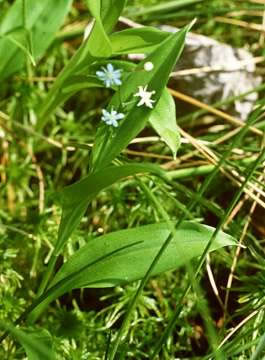
Maianthemum trifolium is a species of flowering plant that is associated with extremely wet environments and is native to Canada and the northeastern United States as well as St. Pierre and Miquelon and Asia (Siberia).
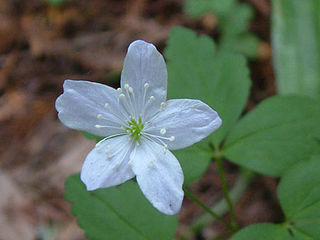
Anemonoides quinquefolia, a flowering plant in the buttercup family Ranunculaceae, is native to North America. It is commonly called wood anemone or windflower, not to be confused with Anemonoides nemorosa, a closely related European species also known by these common names. The specific epithet quinquefolia means "five-leaved", which is a misnomer since each leaf has just three leaflets. A plant typically has a single, small white flower with 5 sepals.

Anemonastrum canadense, synonym Anemone canadensis, the Canada anemone, round-headed anemone, round-leaf thimbleweed, meadow anemone, windflower, or crowfoot, is a herbaceous perennial flowering plant in the family Ranunculaceae. It is native to moist meadows, thickets, streambanks, and lakeshores in North America, spreading rapidly by underground rhizomes. It is valued for its white flowers.

Thalictrum thalictroides, the rue-anemone or windflower, is a herbaceous perennial plant native to woodland in eastern North America. It has white or pink flowers surrounded by a whorl of leaflets, and it blooms in spring.
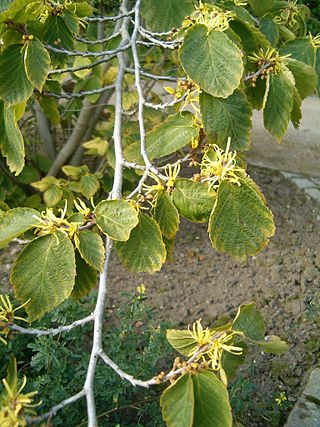
Hamamelis virginiana, known as witch-hazel, common witch-hazel, American witch-hazel and beadwood, is a species of flowering shrub native to eastern North America, from Nova Scotia west to Minnesota, and south to central Florida to eastern Texas.

Anemone hepatica, the common hepatica, liverwort, liverleaf, kidneywort, or pennywort, is a species of flowering plant in the buttercup family Ranunculaceae, native to woodland in temperate regions of the Northern Hemisphere. This herbaceous perennial grows from a rhizome.

Anemone virginiana is an upright growing herbaceous species of flowering plant in the buttercup family Ranunculaceae. It is a perennial that grows 30–80 centimetres (12–31 in) tall, flowering from May until July. The flowers are white or greenish-white. After flowering, the fruits are produced in dense rounded thimble-shaped spikes 15–35 millimetres (0.59–1.38 in) long and 12 millimetres (0.47 in) wide. When the fruits, called achenes, are ripe they have gray-white colored, densely woolly styles, that allow them to blow away in the wind. The leaf structure is whorled halfway up the stem and each individual leaf appears to be deeply cut. It is native from eastern North America, where it is found growing in dry or open woods. This plant can be found in 38 out of the 50 states in the United States and is located anywhere from Maine to Minnesota going west, and found as far south as Georgia and Louisiana.

Anemone caroliniana, the Carolina anemone, is a species of herbaceous flowering plant in the family Ranunculaceae. Plants grow (7)10 to 40 cm tall, from short tuber-like rhizomes that are 10–30 mm long. Stem leaves without petioles. Plants flowering early to mid spring with the flowers composed of 10 to 20 sepals normally white or soft rose colored but also purple, one flower per stem, the sepals are 10 to 22 mm long and 2–5 mm wide. Fruits in heads ovoid to subcylindric in shape, 17–25 mm long.

Anemone parviflora, the northern anemone, or small-flowered anemone, is a herbaceous flowering plant species in the buttercup family Ranunculaceae. Plants grow 10 to 30 cm tall, from a thin, 2 mm thick rhizome. Stem leaves without petioles, basal leaves few with long petioles and deeply three-parted. Plants flowering late spring to mid summer with the flowers composed of five or six sepals normally white or soft bluish colored, 8 to 13 mm long. The plants produce one peduncle with one solitary flower. Fruits in heads ovoid in shape, 10 mm long or less, fruits densely woolly, not winged and with straight 1 to 2.5 mm long beaks.

Anemonoides lancifolia, the lanceleaf anemone or mountain thimbleweed, is an herbaceous plant species in the family Ranunculaceae. The genus occurs in the Southeastern United States. Plants grow 20 to 30 cm tall, growing from a horizontally-orientated rhizome, flowering mid-spring to early summer. The flowers have white sepals that are 12–20 mm long. This species much resembles Anemonoides quinquefolia, of which it was formerly considered a subspecies, except that it is larger growing. After flowering, fruits called achenes are formed in a small cluster; each achene is 3.5–5 mm long, lacks wings and has a straight or partly curved beak that is 1–1.5 mm long.

Pulsatilla occidentalis, synonym Anemone occidentalis, the white pasqueflower or western pasqueflower, is a herbaceous species of flowering plant in the buttercup family Ranunculaceae. Individuals are 10–60 cm (3.9–23.6 in) tall, from caudices, with three to six leaves at the base of the plant that are 3-foliolate, each leaflet pinnatifid to dissected in shape. Leaf petioles are 6–10 cm (2.4–3.9 in) long. Leaves have villous hairs and their margins are pinnatifid or dissected. Plants flower briefly mid-spring to mid-summer, usually soon after the ground is exposed by melting snow. The flowers are composed of five to seven sepals, normally white or soft purple, also mixed white and blueish purple, one flower per stem. The sepals are 15–30 mm (0.59–1.18 in) long and 10–17 mm (0.39–0.67 in) wide. Flowers have 150–200 stamens. The fruit occurs in heads rounded to subcylindric in shape, with pedicels 15–20 cm (5.9–7.9 in) long. The achenes are ellipsoid in shape, not winged, covered with villous hairs, with beaks curved that reflex as they age and 20–40 mm (0.79–1.57 in) long, feather-like. Generally, the fruit persists into fall.
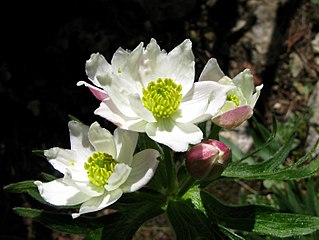
Anemonastrum narcissiflorum, the narcissus anemone or narcissus-flowered anemone, is a herbaceous perennial in the genus Anemonastrum and the buttercup family. Basionym: Anemone narcissiflora Hook. & Arn.

Anemone tuberosa, the desert anemone or tuber anemone, is a herbaceous species of flowering plant in the buttercup family Ranunculaceae. Plants grow 10 to 30, sometimes 40 cm (16 in) tall, from a woody-like tuber shaped like a caudex. Plants have 1 to 3 basal leaves that are 1 or 2 times ternate. The few basal leaves have long petioles and are deeply 3-parted with leaflets lacking stems or rarely with a stalk. Plants flowering early to late spring with the flowers composed of 8 to 10 sepals normally white or pink colored, 10 to 14 mm long. The plants produce one peduncle with one solitary flower or 2–5 flowered cymes. Fruits in heads fusiform in shape, with 7–20 cm (2.8–7.9 in) long pedicels. Fruits called achenes measure 2.5 to 3.5 mm long and 2 to 2.5 mm wide with a rounded outline and flat in shape, densely woolly, not winged also with straight 1.5 mm (0.059 in) long beaks.

Hepatica americana, the round-lobed hepatica, is a herbaceous flowering plant in the buttercup family Ranunculaceae. It is native to the eastern United States and Canada.
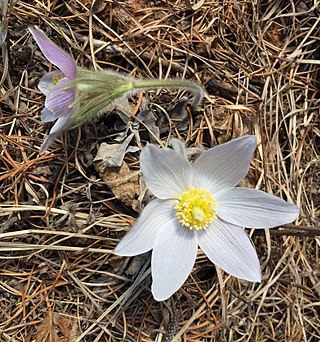
Pulsatilla nuttalliana, known as American pasqueflower, prairie pasqueflower, prairie crocus, or simply pasqueflower, is a flowering plant native to much of North America, from the western side of Lake Michigan, to northern Canada in the Northwest Territories, south to New Mexico in the southwestern United States. Pasqueflower is the provincial flower of Manitoba and the state flower of South Dakota.
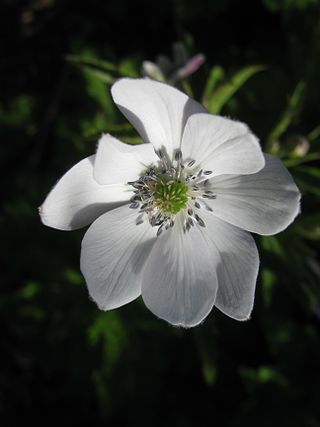
Eriocapitella rivularis, a species of flowering plant in the buttercup family Ranunculaceae, is native to Asia. The specific epithet rivularis means "waterside, of the rivers", which evidently refers to one of its preferred habitats. It is commonly called the riverside windflower. In Chinese, it is called cao yu mei, which means "grass jade plum".

Symphyotrichum racemosum is a species of flowering plant native to parts of the United States and introduced in Canada. It is known as smooth white oldfield aster and small white aster. It is a perennial, herbaceous plant in the family Asteraceae. It is a late-summer and fall blooming flower.






















